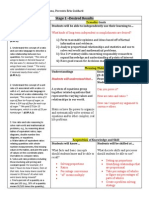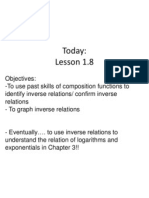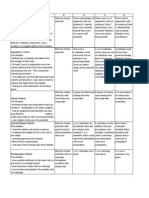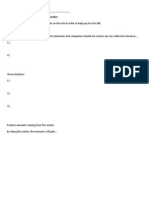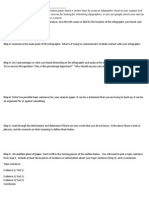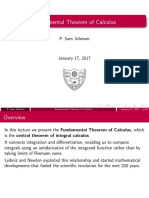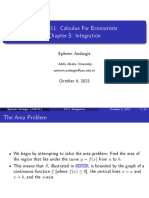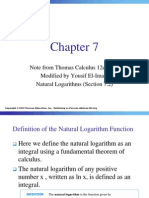Professional Documents
Culture Documents
Integration Link To Riemann Sums
Uploaded by
msbakermathOriginal Title
Copyright
Available Formats
Share this document
Did you find this document useful?
Is this content inappropriate?
Report this DocumentCopyright:
Available Formats
Integration Link To Riemann Sums
Uploaded by
msbakermathCopyright:
Available Formats
Name:__________________
Below is the graph of f(x) = x
2
+ 2. The shaded area is the area of concern. We have bounded the area between f(x)
and the x-axis over the interval [0,1].
1.)
a. Let n= 2, so partition the area over the interval [0,1] into 2 equal sections by drawing lines up to
the f(x) graph. Use these lines as the right-hand endpoints of rectangles.
b. Determine x . ( Hint x =
n
a b
)
c. Use the right endpoints to estimate the upper sum of the area under the curve by filling out the
chart below:
Height of rectangle
f(c
i
)= f( i x )
Width of
rectangle
x
Area = hw
f(c
i
) x
Rectangle i=1
2
2
2
+
,
_
i
= 2
2
1
2
+
,
_
2
1
8
1
2
1
2
1
2
2
1
1
1
]
1
+
,
_
Rectangle i=2
2
2
2
+
,
_
i
=
Total Area:
d.) The area under the curve is 2.
33
or
3
1
2
. How far off were you with your guess?
2.)
a. Let n= 8, so partition the area over the interval [0,1] into 8 equal sections by drawing lines up to
the f(x) graph. Use these lines as the right-hand endpoints of rectangles.
b. Determine x . ( Hint x =
n
a b
)
c. Use the right endpoints to estimate the upper sum of the area under the curve by filling out the
chart below:
Height of rectangle
f(c
i
)= f( i x )
Width of
rectangle
x
Area = hw
f(c
i
) x
Rectangle i=1
2
8
2
+
,
_
i
= 2
8
1
2
+
,
_
8
1
1
1
]
1
+
,
_
8
1
2
8
1
2
Rectangle i=2
2
8
2
+
,
_
i
=
Rectangle i=3
Rectangle i=4
Rectangle i=5
Rectangle i=6
Rectangle i=7
Rectangle i=8
Total Area:
d.) Represent the process of summing up the 8 rectangles you just calculated in the chart, using
sigma/summation notation for representing.
3.) Draw a picture of the graph f(x) = x
2
+ 2 over the interval [0,1] such that the area under the curve is
partitioned into an infinite amount of rectangles bounded by the curve.
4.) Let n not be defined by a real number. In other words, n is just n, we will partition the interval [0,1] into n
pieces. Use sigma/summation notation to represent the area under the curve f(x) = x
2
+ 2 over the interval
[0,1] if you partition the area into n rectangles.
5.) Find the limit as n-> of the summation of the n rectangles as you have found in problem number 4. In
other words find
x c f
i
n
i
x
) ( lim
1
(Hint: Use the summation formulas from page 399 of your textbook to get rid of sigma notation)
6.) Find F(x) of f(x) = x
2
+2. In other words, integrate f(x), or find the antiderivative of f(x).
Remember the notation: F(x) =
+ 2
2
x
dx.
7.) Find
+
2
1
2
2 x dx by completing parts a c below
a.) Use your answer from 7 and find F(2)
b.) Find F(1)
c.) Use the fundamental Theorem of Calculus to find
+
2
1
2
2 x dx = F(2)- F(1)
8.) Explain the link between limits of Riemann Sums and integration.
9.) Challenge: Find the area bounded by the equation y = x
2
+2 ; y = x + 2 ; x=0 ; and x = 1
You might also like
- GraphDocument1 pageGraphmsbakermathNo ratings yet
- Radio Projects Feedback and RubricDocument12 pagesRadio Projects Feedback and RubricmsbakermathNo ratings yet
- Chapter 7 - Ratios and PercentsDocument4 pagesChapter 7 - Ratios and Percentsmsbakermath100% (1)
- 6.3 Vector IntroDocument3 pages6.3 Vector IntromsbakermathNo ratings yet
- Chapter 5 QuizDocument1 pageChapter 5 QuizmsbakermathNo ratings yet
- 7.5 Percent Change Argument PracticeDocument3 pages7.5 Percent Change Argument PracticemsbakermathNo ratings yet
- OutlineRubric For Argument PaperDocument4 pagesOutlineRubric For Argument PapermsbakermathNo ratings yet
- Newton's Law ProjectDocument1 pageNewton's Law ProjectmsbakermathNo ratings yet
- Panel QuestioningDocument1 pagePanel QuestioningmsbakermathNo ratings yet
- Graphing SinusoidsDocument9 pagesGraphing SinusoidsmsbakermathNo ratings yet
- Radio Project Objective Sheet and RubricDocument2 pagesRadio Project Objective Sheet and RubricmsbakermathNo ratings yet
- 6.3 Vector Operation ActivityDocument1 page6.3 Vector Operation ActivitymsbakermathNo ratings yet
- Home EnergyDocument8 pagesHome EnergymsbakermathNo ratings yet
- Outline For Argument PapersDocument2 pagesOutline For Argument PapersmsbakermathNo ratings yet
- Inverse FunctionsDocument16 pagesInverse FunctionsmsbakermathNo ratings yet
- Linear Programming Project OutlineDocument4 pagesLinear Programming Project OutlinemsbakermathNo ratings yet
- Peer Debate EvalDocument2 pagesPeer Debate EvalmsbakermathNo ratings yet
- Algebra Bootcamp Part 1Document2 pagesAlgebra Bootcamp Part 1msbakermathNo ratings yet
- Logarithms and Exponentials-Depreciation of ValueDocument23 pagesLogarithms and Exponentials-Depreciation of ValuemsbakermathNo ratings yet
- 3.3 Properties and Basic Limits WS DiscussionDocument1 page3.3 Properties and Basic Limits WS DiscussionmsbakermathNo ratings yet
- Rubric For DebateDocument1 pageRubric For DebatemsbakermathNo ratings yet
- Boot Camp 2Document2 pagesBoot Camp 2msbakermathNo ratings yet
- Debate Edited ProceduresDocument8 pagesDebate Edited ProceduresmsbakermathNo ratings yet
- Depreciation WSDocument1 pageDepreciation WSmsbakermathNo ratings yet
- Debate OutlineDocument1 pageDebate OutlinemsbakermathNo ratings yet
- Linear ProgrammingDocument12 pagesLinear ProgrammingmsbakermathNo ratings yet
- Log WSDocument1 pageLog WSmsbakermathNo ratings yet
- Infographic Analysis ExampleDocument4 pagesInfographic Analysis ExamplemsbakermathNo ratings yet
- Infographic Argument Paper Project OutlineDocument3 pagesInfographic Argument Paper Project OutlinemsbakermathNo ratings yet
- The Subtle Art of Not Giving a F*ck: A Counterintuitive Approach to Living a Good LifeFrom EverandThe Subtle Art of Not Giving a F*ck: A Counterintuitive Approach to Living a Good LifeRating: 4 out of 5 stars4/5 (5784)
- The Yellow House: A Memoir (2019 National Book Award Winner)From EverandThe Yellow House: A Memoir (2019 National Book Award Winner)Rating: 4 out of 5 stars4/5 (98)
- Never Split the Difference: Negotiating As If Your Life Depended On ItFrom EverandNever Split the Difference: Negotiating As If Your Life Depended On ItRating: 4.5 out of 5 stars4.5/5 (838)
- Shoe Dog: A Memoir by the Creator of NikeFrom EverandShoe Dog: A Memoir by the Creator of NikeRating: 4.5 out of 5 stars4.5/5 (537)
- The Emperor of All Maladies: A Biography of CancerFrom EverandThe Emperor of All Maladies: A Biography of CancerRating: 4.5 out of 5 stars4.5/5 (271)
- Hidden Figures: The American Dream and the Untold Story of the Black Women Mathematicians Who Helped Win the Space RaceFrom EverandHidden Figures: The American Dream and the Untold Story of the Black Women Mathematicians Who Helped Win the Space RaceRating: 4 out of 5 stars4/5 (890)
- The Little Book of Hygge: Danish Secrets to Happy LivingFrom EverandThe Little Book of Hygge: Danish Secrets to Happy LivingRating: 3.5 out of 5 stars3.5/5 (399)
- Team of Rivals: The Political Genius of Abraham LincolnFrom EverandTeam of Rivals: The Political Genius of Abraham LincolnRating: 4.5 out of 5 stars4.5/5 (234)
- Grit: The Power of Passion and PerseveranceFrom EverandGrit: The Power of Passion and PerseveranceRating: 4 out of 5 stars4/5 (587)
- Devil in the Grove: Thurgood Marshall, the Groveland Boys, and the Dawn of a New AmericaFrom EverandDevil in the Grove: Thurgood Marshall, the Groveland Boys, and the Dawn of a New AmericaRating: 4.5 out of 5 stars4.5/5 (265)
- A Heartbreaking Work Of Staggering Genius: A Memoir Based on a True StoryFrom EverandA Heartbreaking Work Of Staggering Genius: A Memoir Based on a True StoryRating: 3.5 out of 5 stars3.5/5 (231)
- On Fire: The (Burning) Case for a Green New DealFrom EverandOn Fire: The (Burning) Case for a Green New DealRating: 4 out of 5 stars4/5 (72)
- Elon Musk: Tesla, SpaceX, and the Quest for a Fantastic FutureFrom EverandElon Musk: Tesla, SpaceX, and the Quest for a Fantastic FutureRating: 4.5 out of 5 stars4.5/5 (474)
- The Hard Thing About Hard Things: Building a Business When There Are No Easy AnswersFrom EverandThe Hard Thing About Hard Things: Building a Business When There Are No Easy AnswersRating: 4.5 out of 5 stars4.5/5 (344)
- The Unwinding: An Inner History of the New AmericaFrom EverandThe Unwinding: An Inner History of the New AmericaRating: 4 out of 5 stars4/5 (45)
- The World Is Flat 3.0: A Brief History of the Twenty-first CenturyFrom EverandThe World Is Flat 3.0: A Brief History of the Twenty-first CenturyRating: 3.5 out of 5 stars3.5/5 (2219)
- The Gifts of Imperfection: Let Go of Who You Think You're Supposed to Be and Embrace Who You AreFrom EverandThe Gifts of Imperfection: Let Go of Who You Think You're Supposed to Be and Embrace Who You AreRating: 4 out of 5 stars4/5 (1090)
- The Sympathizer: A Novel (Pulitzer Prize for Fiction)From EverandThe Sympathizer: A Novel (Pulitzer Prize for Fiction)Rating: 4.5 out of 5 stars4.5/5 (119)
- Her Body and Other Parties: StoriesFrom EverandHer Body and Other Parties: StoriesRating: 4 out of 5 stars4/5 (821)
- Simbawa Oliver Task 2 Reading Report Calculus and Its Application To PhysicsDocument3 pagesSimbawa Oliver Task 2 Reading Report Calculus and Its Application To PhysicsOliver SimbawaNo ratings yet
- The Fundamental Theorem of CalculusDocument48 pagesThe Fundamental Theorem of CalculusManjunath MaigurNo ratings yet
- 2nd PT-Basic Calculus-Final Exam-2022-2023Document4 pages2nd PT-Basic Calculus-Final Exam-2022-2023Diane GuilaranNo ratings yet
- Questions With SolutionDocument14 pagesQuestions With SolutionEmiline Barcent Jloise AcompanadoNo ratings yet
- Calculus MOOC: Fundamental Theorem and Indefinite IntegralsDocument4 pagesCalculus MOOC: Fundamental Theorem and Indefinite IntegralsRodante P Hernandez Jr.No ratings yet
- Basic Cal Q4 Module 6Document22 pagesBasic Cal Q4 Module 6John Carlo RafaelNo ratings yet
- Active Calculus CH 1-8 Activities (v.8.5.13) PDFDocument224 pagesActive Calculus CH 1-8 Activities (v.8.5.13) PDFDr Milan Glendza Petrovic NjegosNo ratings yet
- Module 9 of Calculus 2Document9 pagesModule 9 of Calculus 2Jimbo J. AntipoloNo ratings yet
- Calculus Single Variable 7th Edition Deb (316-330)Document15 pagesCalculus Single Variable 7th Edition Deb (316-330)Carlos Rios PradaNo ratings yet
- Chapter 5 IntegrationDocument61 pagesChapter 5 IntegrationefiNo ratings yet
- BasicCalculus - G11 - Q4Mod5 - Antiderivatives and Reimann IntegralDocument41 pagesBasicCalculus - G11 - Q4Mod5 - Antiderivatives and Reimann IntegralMARLA RUBY PAZ YTINGNo ratings yet
- Syllabus Jan09 MAT183Document2 pagesSyllabus Jan09 MAT183Mike ZakwanNo ratings yet
- Active Calculus CH 1-8 (v.8.19.13) PDFDocument523 pagesActive Calculus CH 1-8 (v.8.19.13) PDFDr Milan Glendza Petrovic NjegosNo ratings yet
- Before Calculus: September 30, 2011 18:19 Ftoc Sheet Number 1 Page Number XiiiDocument5 pagesBefore Calculus: September 30, 2011 18:19 Ftoc Sheet Number 1 Page Number XiiiDaniel VargasNo ratings yet
- Mgre NotesDocument319 pagesMgre NotesHan JuliaNo ratings yet
- Introduction To Differential Equations: Jeffrey R. ChasnovDocument128 pagesIntroduction To Differential Equations: Jeffrey R. ChasnovMargono SoplantilaNo ratings yet
- The Idea of IntegralDocument11 pagesThe Idea of IntegralYumie YamazukiNo ratings yet
- Areas and Definite IntegralsDocument20 pagesAreas and Definite IntegralsMichael OpenaNo ratings yet
- Forrest Math148notesDocument199 pagesForrest Math148notesphoebezzNo ratings yet
- MathII Ch07 3 Natural LogarithmsDocument18 pagesMathII Ch07 3 Natural LogarithmsinsidemeNo ratings yet
- Evaluation of Definite Integrals PDFDocument2 pagesEvaluation of Definite Integrals PDFDaleNo ratings yet
- Basic Cal-Q4-Module-4Document17 pagesBasic Cal-Q4-Module-4Jessa Cuanan Calo100% (1)
- Calculus Chapter on Definite IntegralsDocument23 pagesCalculus Chapter on Definite IntegralsAlisha VergaraNo ratings yet
- Review Math FoundationDocument8 pagesReview Math FoundationPrince Arc MiguelNo ratings yet
- RiemannDocument4 pagesRiemannZsolt BarkóNo ratings yet
- Integral Calculus With Applications To The Life Sciences PDFDocument286 pagesIntegral Calculus With Applications To The Life Sciences PDFYaseen GhulamNo ratings yet
- MPPT8 The Definite Integral and ApplicationsDocument44 pagesMPPT8 The Definite Integral and ApplicationsStandardNo ratings yet
- Derivative Review Worksheet SolutionsDocument20 pagesDerivative Review Worksheet Solutionsian jheferNo ratings yet
- Calculus - Wikipedia, The Free EncyclopediaDocument14 pagesCalculus - Wikipedia, The Free EncyclopediahlkjhlkjhlhkjNo ratings yet
- MA20218 Analysis 2A: Lecture NotesDocument62 pagesMA20218 Analysis 2A: Lecture NotesAlex DurstonNo ratings yet


